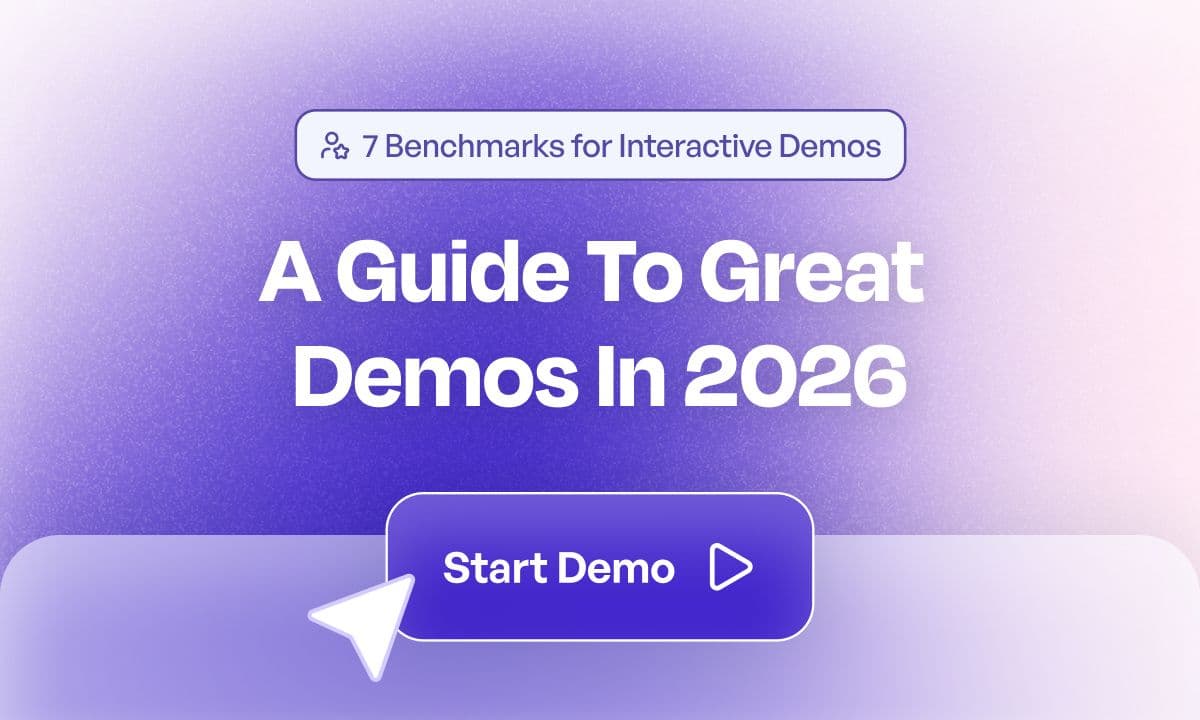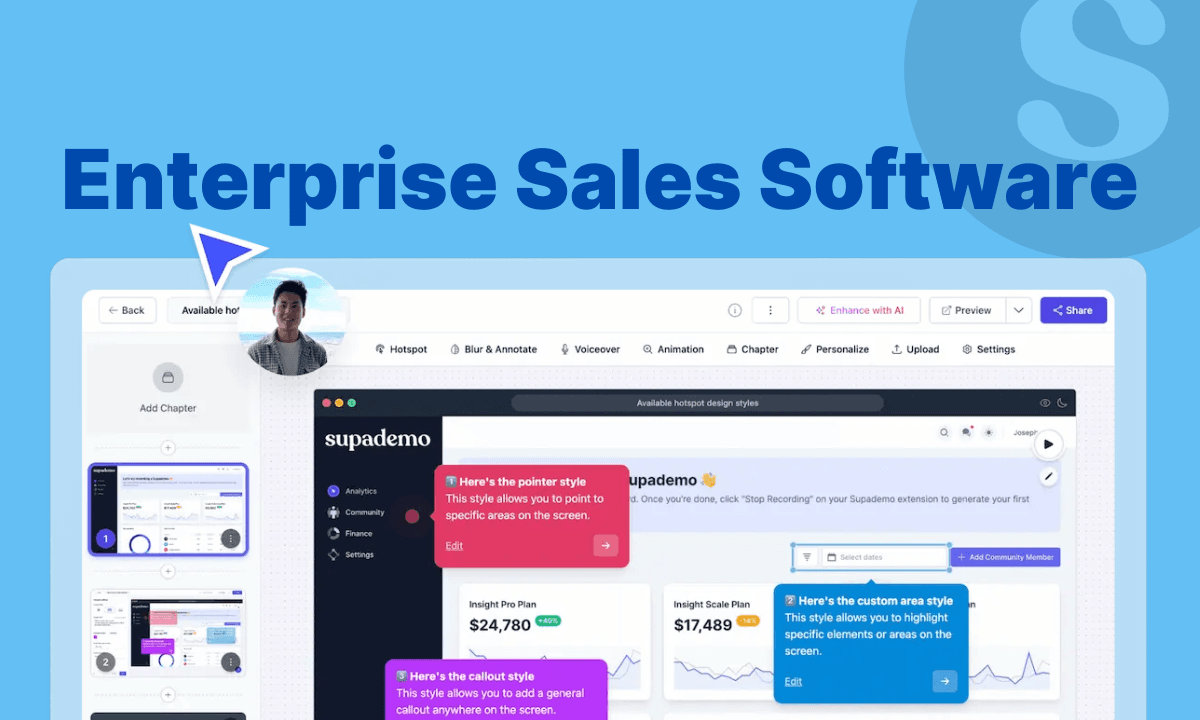
The B2B sales game has completely changed. Today's buyers involve 8.2 stakeholders in purchasing decisions—up 21% since 2015—and spend only 17% of their time actually meeting with suppliers. Traditional sales pitches? They're not cutting it anymore
Today's buying committees demand more than features and benefits. They want proof. Real, tangible evidence that your solution works within their specific business context, integrates with their existing systems, and delivers measurable ROI.
Sales Proof of Concepts (POCs) have emerged as the definitive answer to this challenge. Unlike static demos or lengthy trial periods, strategic POCs provide structured, hands-on validation that builds confidence across entire buying committees.
In this guide, we’ll break down everything you need to know about sales POCs—what POC means in business, why sales POCs matter, and how to execute them effectively using interactive demos.
What is POC in sales?
A sales POC is a hands-on trial or practical evaluation that allows buyers to evaluate your product’s capabilities, integration potential, and ROI within their specific environment—all before making a purchasing decision.
Unlike traditional sales demos, which focus on showcasing product features, a sales POC is the bridge between interest and investment—giving prospects the confidence that your solution can solve their problems.
How is a sales POC different from other evaluation methods?
The evaluation landscape includes demos, trials, POCs, pilots, and POVs—each designed for different stages of the buyer journey and varying levels of purchase complexity.
Here's a detailed breakdown of each evaluation method:
| Evaluation Method | Purpose | Ideal Use Case |
|---|---|---|
| Proof of Concept (POC) | Validates technical feasibility and integration within the prospect’s environment. | When technical validation is required before commitment. |
| Demo | Provides an overview of product features. | During initial sales discussions. |
| Free Trial | Offers limited-time access to the product. | For straightforward, self-service products. |
| Pilot | Implements the solution on a small scale within the prospect’s organization. | When assessing full-scale deployment. |
| Proof of Value (POV) | Demonstrates measurable business benefits and ROI. | When financial justification is needed for stakeholder approval. |
Types of Sales POCs in 2026
Not every prospect needs the same level of validation. Your POC approach should match their evaluation style, technical complexity, and organizational needs. Here are three strategic approaches that work:
1. Self-service POCs
2. Guided POCs
3. Enterprise pilot programs
Why must POCs be interactive?
Today’s buyers demand control over their purchasing journey. A 2025-ready POC should:
- Offer self-service exploration—buyers want hands-on experience, not just guided sessions.
- Provide real-time engagement data—insights into how prospects interact with the product help refine the sales approach.
- Reduce setup friction—traditional POCs take weeks; interactive POCs can be deployed in hours.
Pro Tip
: Interactive POCs can serve as training materials for post-sale onboarding, maximizing their value beyond the sales process.
Why does a sales PoC matter in B2B sales?
B2B deals are high-stakes commitments—more like buying a house than picking out a new pair of shoes.
You wouldn’t purchase a home after just viewing photos—you’d want a walkthrough, check the plumbing, and make sure it fits your needs.
That’s exactly what a sales POC offers: a hands-on trial to validate the product’s fit before committing. It helps buyers test features, integrations, and workflows—reducing risk and accelerating deal confidence.
Without a POC, the buyer is making a blind decision, hoping everything will work out. But with a structured POC, they gain confidence that the investment is solid, reducing hesitation and accelerating the purchase process. As Michael Humblet explains in his LinkedIn post.
Take ProcessMaker, a workflow automation enterprise. Their sales team struggled with friction in the early demo process, requiring custom-built demos for every prospect, which led to delays and inefficiencies.
By adopting Supademo, an interactive demo automation platform, they:
✅ Automated early-stage POCs, eliminating the need for custom demos for unqualified leads.
✅ Reduced sales cycle friction and saved 8-10 hours each week per sales rep, allowing prospects to explore features instantly instead of waiting for scheduled calls.
✅ Double-digit % increase in deals closed, as buyers could self-educate and gain confidence in the product’s capabilities.
Here's an example of a sales POC of Mixpanel created using Supademo's sandbox mode ✨
What are the benefits of a sales POC?
Implementing a Sales Proof of Concept (POC) can significantly improve deal outcomes in modern B2B sales—especially when buyers expect proof over promises.
Here are the key benefits of running an effective sales POC:

1. Higher buyer confidence, reduced buyer risk
Allowing prospects to interact directly with a product through a sales POC fosters trust and assurance in the solution's capabilities. In fact, studies show that 63% of buyers expect companies to provide detailed proof of ROI before making a purchasing decision.
2. Shorter sales cycles
Interactive POCs enable prospects to explore and validate solutions at their own pace, reducing the need for prolonged meetings and follow-ups. A report on B2B buying behavior in 2025 confirms that 91% of buyers come to sales meetings already familiar with the vendor. This self-service approach aligns with modern buyer preferences for autonomy and efficiency, leading to shorter sales cycles and client stickiness.
What's a key aspects of client retention, word of mouth, and stickiness?
Demonstrating a tangible ROI or benefit early on
It's not just enough to have ROI, it's the psychological impact sooner than they expect and having it be noticeable
Make sure you are able to deliver this…— Angel Investor Guy (@AngelInvestGuy) March 11, 2025
3. Better deal conversion rates
Hands-on experiences through POCs allow prospects to see firsthand how a solution addresses their specific challenges, increasing the likelihood of conversion. A well-executed customer POC serves as a critical tool in the sales process to address customer concerns and demonstrate the value they can deliver.
4. Stronger differentiation from competitors
Offering a tailored POC demo demonstrates a company's commitment to addressing a prospect's unique needs, setting them apart from competitors who may rely solely on generic presentations. This personalized approach showcases the solution's real-world applicability and effectiveness, making it more compelling to potential buyers.
5. Improves stakeholder alignment and buy-in
Enterprise deals often involve multiple stakeholders across different departments. A sales POC acts as a unifying touchpoint by letting stakeholders experience the solution together—either through live walkthroughs or self-paced demos. This reduces friction, aligns priorities, and helps decision-makers get on the same page faster, ultimately leading to smoother approvals and stronger consensus.
6. Smarter data-driven sales
Modern POC tools (like Supademo) capture valuable engagement data—such as where users click, how much time they spend on certain flows, and what features they revisit. Sales teams can use these insights to personalize their follow-ups, address specific objections, and highlight the most relevant parts of the product. This level of precision results in higher-quality conversations and better close rates.
Incorporating interactive POCs into the sales process not only enhances the buyer's experience but also
equips sales teams
with the tools and insights necessary to close deals more efficiently and effectively.
How to run a sales POC?
A successful sales POC follows a structured approach that aligns with buyer needs while remaining scalable for your sales team. The goal is to make the evaluation process seamless, engaging, and data-driven, ultimately driving faster deal closures. Here’s a 5-step framework to execute an effective POC while leveraging Supademo’s interactive capabilities.

Step 1: Identify prospect needs and success criteria
Before running a POC, it’s crucial to align expectations with the prospect. You need to identify their business pain points, goals, and technical requirements to create a relevant and results-driven experience.
How to identify prospect needs?
✔ Conduct discovery calls to understand key use cases, blockers, and integration needs.
✔ Define success metrics tied to their business objectives (e.g., 20% improvement in workflow efficiency or 30% cost savings).
✔ Use Supademo’s pre-POC analytics to gauge how prospects interacted with early-stage demos and what features intrigued them the most.
🎉
, a healthcare platform, struggled with onboarding medical professionals and educators efficiently. By leveraging Supademo, they built interactive product tours tailored to different healthcare roles, allowing users to self-navigate through their solution before live engagement. This led to 100+ customers onboarded and saved 12 hours per month on manual onboarding efforts.
Step 2: Design an interactive POC experience
Traditional POCs often require manual setup and heavy onboarding, leading to long sales cycles. Instead, an interactive POC enables self-service evaluation without complex configurations.
This shift is reflected in how teams measure impact. According to the State of Interactive Demos 2026 report, 62% of teams rate interactive demos as having a high impact on improving sales efficiency, highlighting how hands-on, self-serve experiences reduce friction earlier in the sales process.
This is where Supademo's sandbox mode transforms how sales teams create and deliver POCs. Rather than building custom environments from scratch, you can rapidly deploy realistic, interactive POC experiences that feel like the real product.
How to design an interactive sales POC experience?
✔ Capture high-fidelity sandbox clones via Chrome extension or desktop app, mirroring your product’s UI without engineering dependency.
✔ Customize environments with tailored dummy data and branding—swap logos, names, colors, and data to reflect each prospect’s context.
Here's an example of Stripe sandbox demo:
✔ Enable self-exploration and track engagement with Supademo analytics, generating real-time usage insights for targeted follow-up.
🎉
, a marketing reporting platform, faced challenges in educating prospects on its complex data visualization features. By integrating Supademo-powered tutorials into their POCs, they simplified feature adoption, leading to a 25% increase in engagement and 50% reduction in time spent creating manual guides.
Step 3: Collaborate with prospects in real-time
POCs fail when they’re treated as "set it and forget it" trials. Successful vendor proof-of-concepts require ongoing collaboration between the vendor and the prospect’s team.
How to collaborate with prospects?
✔ Kick off the POC with a live session (Zoom, Teams) to walk prospects through the experience.
✔ Provide on-demand access to Supademo, allowing the buyer to explore the solution at their own pace.
✔ Set up asynchronous touchpoints via Slack, email, or a shared digital workspace for continuous feedback.
🎉
, a platform for collecting and sharing testimonials, needed to improve website engagement and self-service product education. By embedding Supademo-powered interactive tours into their website, they achieved 100,000+ unique views and a 14% engagement rate, allowing prospects to explore features in real time.
Step 4: Track engagement and iterate
Most sales teams run blind when executing POCs, waiting for feedback that may never come. With Supademo’s built-in analytics, sellers can track engagement in real-time and adjust accordingly.
How to track engagement in a sales POC?
✔ Monitor unique clicks and conversion rates for different hotspots using Supademo analytics.
✔ Identify drop-off points, where buyers disengage, and proactively address friction areas.
✔ Adapt the POC on the fly based on how buyers interact with the product.
🎉
, a community engagement platform, struggled with helping prospects understand how to build online communities. Using Supademo analytics, they tracked which features users interacted with the most and where they dropped off. By iterating their interactive demos, they produced 80+ guides, reducing support workload by three hours per week.
Step 5: Present results and close the deal
Once the POC concludes, sales teams must quantify results and present a compelling case for full adoption. Buyers don’t just need to see that the product works—they need proof of ROI and business impact.
How to present ROI in a sales POC?
✔ Use Supademo engagement analytics to highlight how much time prospects spent on each feature—validating interest.
✔ Compare pre-POC vs. post-POC efficiency metrics, reinforcing ROI (e.g., 30% process automation improvement).
✔ Integrate POC data with CRMs like Salesforce or HubSpot, and possibly AI SDR tools, to correlate engagement with deal movement.
🎉
, a video testimonial collection platform, faced challenges in educating users on the benefits of self-service video reviews. By leveraging Supademo analytics, they showcased feature engagement data to prospects, proving user adoption potential. This resulted in a 15% increase in website demo tour engagement and reduced one-on-one support hours by three per week.
What are common sales POC challenges?
| Challenge | Solution |
|---|---|
| Misaligned expectations | Use Supademo to create pre-POC demos that align teams. Track scope in tools like Notion or Trello to keep deliverables clear. |
| Scope creep | Define and share a POC scope document in Confluence or Google Docs. Use Monday.com to log and assess new requests. |
| Technical glitches | Run a sandbox test using Docker or AWS. Use Zapier or Make.com for lightweight integrations. Track bugs via Jira. |
| Engagement drop-off | Deliver self-paced POCs via Supademo. Automate reminders with Intercom or Drift. Assign a success manager to support the prospect. |
| Lack of stakeholder buy-in | Track feature use with Supademo analytics. Share insights via Salesforce or HubSpot and visualize ROI with Google Data Studio. |
| Unstructured feedback loops | Collect feedback using Typeform or Google Forms. Keep communication open in a shared Slack Connect channel. |
The future of sales POCs: interactive & AI-driven
Interactive, AI-enhanced POCs demonstrate tangible value by offering:
✔ Personalized content: AI tailors messaging to each buyer’s pain points, delivering more relevant and impactful experiences.
✔ Real-time feedback: Interactive tools give prospects hands-on access to features and instant insight into capabilities.
✔ Data-driven insights: Built-in analytics help sales teams refine strategy based on actual engagement behavior.
Traditional POCs often rely on static presentations that fail to meet each prospect’s unique needs. With sales enablement tools like Supademo, sales teams create tailored, self-guided demos that resonate more deeply. When combined with a digital sales room software, sellers can monitor user interactions in real-time and adjust messaging accordingly.
Industry leaders agree: AI is transforming sales. A Columbia Business School article notes how automation is reshaping the funnel—from lead gen to closing. Embracing this shift means faster, more relevant POCs and higher deal velocity.
A modern sales POC is more than a trial or simple demo—it’s a personalized, data-backed experience. With Supademo, you can create engaging, interactive, and data-driven POCs that win deals faster.
👉 Ready to transform your sales POC process? Try Supademo today.
FAQs
Commonly asked questions about this topic.
What’s the difference between a demo, a free trial, and a POC?
A demo is a guided feature tour led by sales, lasting 30 to 60 minutes. A free trial gives limited self-service product access for 7 to 30 days. A POC is a structured, hands-on test in the prospect’s environment, lasting 2 to 8 weeks, with defined success criteria and ongoing collaboration.
How long should a sales POC run?
Aim for 2 to 4 weeks for mid-market deals and 4 to 8 weeks for enterprise projects. Set clear milestones such as technical integration tests, workflow validations, and user adoption checks at the outset. Shorter, goal-oriented POCs with tight scope often outperform open-ended trials by delivering quicker, measurable outcomes.
When should you decline a POC request?
Politely say no if prospects lack budget authority, clear success criteria, or stakeholder commitment. Avoid POCs with unrealistic timelines or without basic product fit confirmation. Reserve POC resources for qualified opportunities where technical validation is the primary barrier, ensuring efficient use of sales engineering effort.
How do you measure POC success and ROI?
Define metrics up front including integration success rates, performance benchmarks, efficiency gains, and feature usage stats. Track engagement via analytics such as time on key workflows, hotspot clicks, and drop-off points. A successful POC achieves predefined technical or business metrics and accelerates deal progression within 30 to 60 days post completion.
Can you run multiple POCs at scale?
Yes, by templating common workflows and using Supademo’s sandbox mode for rapid environment cloning and customization. Create base POC frameworks, then swap in prospect-specific data and branding. This approach lets you execute multiple POCs simultaneously while preserving personalization and minimizing engineering overhead.
Neelabja Adkuloo
Neelabja blends 10 years of content marketing experience with journalism skills like interviewing and research. From strategy to distribution, she brings a full-spectrum approach to content creation.







